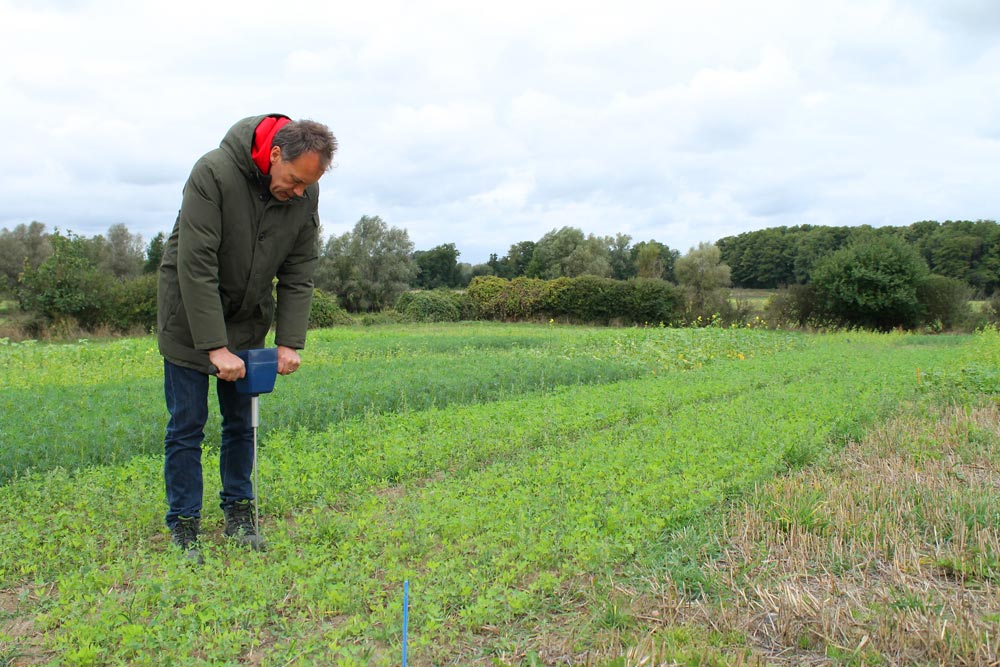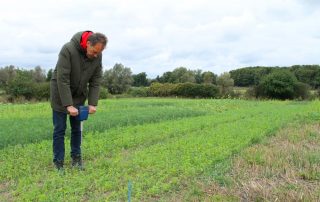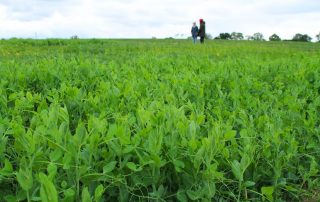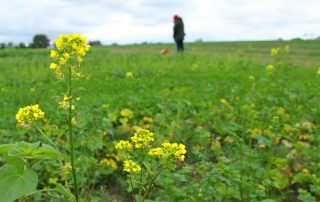
Cereals under drought Stress
Researchers in Berge deliberately expose winter cereal varieties to heat stress
Cereals under drought Stress
Farmers in Brandenburg are also feeling the effects of the increasing drought in Germany. The local sandy soils store water only to a limited extent anyway. The Berge Agricultural Research Station is now investigating arable crops under rising temperatures and increasing drought under Brandenburg site conditions.
It is getting hotter in Germany and thus also in Brandenburg. According to the German Weather Service, it has become about 1.3 degrees warmer in the state since 1881. The weather station at the Berge Experimental Station in Havelland has also recorded a “temperature increase in the annual mean of about 2.6 degrees within the last 70 years”, reports the head of the experimental station, Dr Andreas Muskolus.
Longer lasting high temperatures leave clear traces in nature. Farmers in particular feel the effects: without water in the soil, plants have problems with nutrient transport and photosynthesis. This leads to declining yields.
Winter cereals grow on more than 50 percent of Brandenburg’s arable land. This raises the question: What is the demonstrable effect of heat and drought stress on winter wheat, winter rye and winter barley? The Berge Experimental Station in Havelland, 40 kilometres west of Berlin, has been researching this since June 2020. The project is funded by the Ministry of Agriculture, Environment and Climate Protection (MLUK). It was initiated by the Coordination Office for Experiments at the Institute for Food and Environmental Research (ILU). (ILU). The idea came about after discussions with the Brandenburg Farmers’ Association. The project organiser is the Association for the Promotion of Agricultural and Urban Ecological Projects e. V. (A.S.P.), which runs the Berge Experimental Station with its Institute for Agricultural and Urban Ecological Projects (IASP).
The project comprises two main questions, firstly: Which of the three crops is best adapted to heat stress on sites in Brandenburg? Secondly: Since the cultivation of catch crops is standard in agricultural practice, the scientists in Berge are also looking for answers to how the cultivation of different catch crops affects water availability for the following main crop.
In order to investigate the effects of high temperatures on cereals, the researchers in Berge want to specifically expose the three winter cereal varieties mentioned to heat stress. For this purpose, they established 144 experimental plots, each 15 square metres in size, on an experimental area in Berge in autumn 2020. Winter wheat, winter rye and winter barley were then sown on these plots. When the grain grows next year, the researchers will use aids: Foils are laid over the crop on hot days to artificially raise the temperature further during the flowering and grain-filling phase. After all, the effects of heat and drought should take place under conditions that are as planned and controlled as possible. Sensors permanently measure the temperatures under the film at the level of the ears. The data is stored and regularly evaluated.
Targeted irrigation of the area is also used to investigate how water, or the lack of it, influences the yield and quality effects of heat. In order to be able to compare the results, the staff at the Berge Experimental Station also sowed the three types of cereal (each in three different varieties) on a second plot. Here, heat stress is avoided by shading the stand with white flow during the day when temperatures are high. After harvesting, the yields and qualities of grain and straw are compared with the plots without heat stress.
Do clover and field bean influence the water balance?
Intercrops increase soil fertility and erosion control. In order to clarify how catch crops influence the water availability of the main crop, the researchers in Berge cultivated twelve catch crops on a total of 56 experimental plots of 30 square metres each. In July, six types of catch crops were initially sown on part of the plots (Persian clover, Alexandrian clover, grain peas, field bean, mixtures with buckwheat, mixtures with sunflowers). In order to reflect the usual agricultural procedure and to ensure a practical trial, winter wheat was grown on the plots beforehand. In September, the scientists sowed six more types of catch crop (field mustard, phacelia, rye, buckwheat, winter vetch, welsh ryegrass) on the remaining plots, which followed silage maize. On the field, the head of the experimental station, Dr Andreas Muskolus, and his staff measure air and soil moisture on a weekly basis.
Now, in autumn, the catch crops are close together. Some of the 30-square-metre plots have not been cultivated. In one area, the stubble of the previously grown grain is still clearly visible. “Stubble acts like capillaries,” explains Dr Muskolus. So it is possible that the area there loses a little more water. There is also a fallow area. Both serve as a comparison to the cultivated field. But the experiments are still at the very beginning. However, Muskolus has already made one experience: there are already big differences between the soil water contents of different catch crops.
The research team will reach a first intermediate step in April 2021, when the catch crops will be harvested and the yield determined on the basis of the entire plant. Silage maize will then be sown. Meanwhile, the measurement of soil moisture will continue. The maize crop can then be used to determine the yield effect of the catch crop on the subsequent crop from late summer 2021.
Now, in autumn, the catch crops are close together. Some of the 30-square-metre plots have not been cultivated. On one plot, for example, the stubble of the previously grown cereal can still be clearly seen. “Stubble acts like capillaries,” explains Dr Muskolus. So it is possible that the area there loses a little more water. There is also a fallow area. Both serve as a comparison to the cultivated field. But the experiments are still at the very beginning. However, Muskolus has already made one experience: there are already big differences between the soil water contents of different catch crops.
The research team will reach a first intermediate step in April 2021, when the catch crops will be harvested and the yield determined on the basis of the entire plant. Silage maize will then be sown. Meanwhile, the measurement of soil moisture will continue. The maize crop can then be used to determine the yield effect of the catch crop on the subsequent crop from late summer 2021.
Photo source: Coordination Office for Experimental testing/ILU



